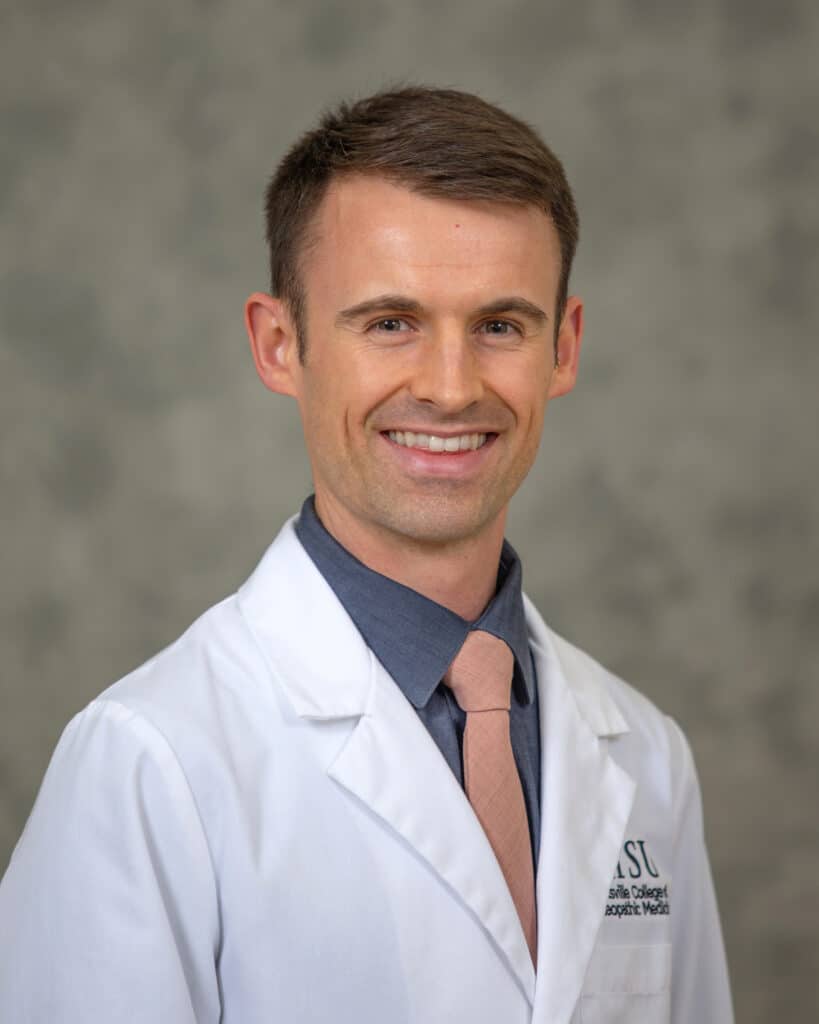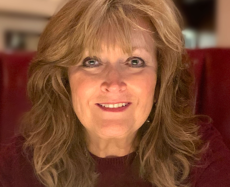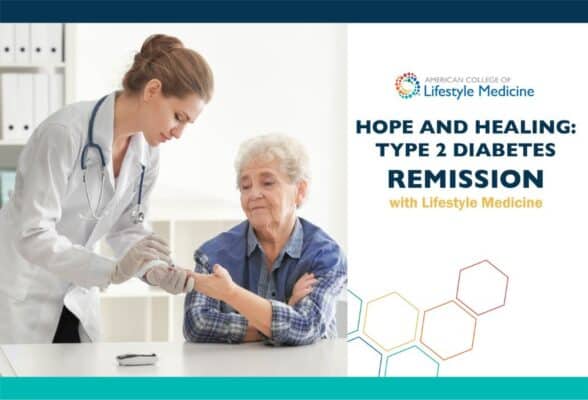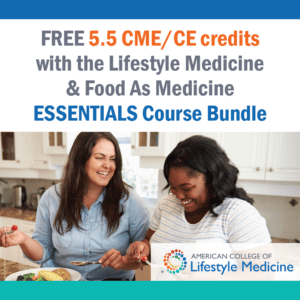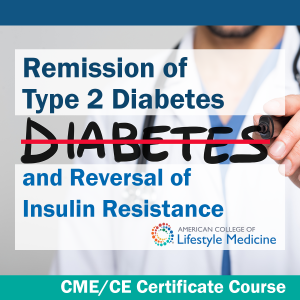Reigniting the flame: a medical student’s journey with lifestyle medicine
By Sally Crocker
Jaron Gerber was unhappy, unhealthy and reconsidering whether he really wanted to become a doctor before he discovered lifestyle medicine.

Jaron Gerber was a first-year medical student and already felt burned out. Migraine headaches, which had affected him since childhood, stress from becoming a new parent and the rigors of medical school left him feeling unsatisfied and unhealthy. His medical school courses were challenging and time intensive, but Jaron wasn’t finding the healthy lifestyle component or satisfaction he sought within them.
Despite a long-time interest in healthy lifestyles and longevity, he considered a career change.
Hoping to find an area of medicine that would motivate Jaron to stay the course, his wife started an intensive Google search. She stopped when she found the American College of Lifestyle Medicine (ACLM).
“I was blown away by how well ACLM’s lifestyle medicine philosophy and residency curriculum matched what I wanted to do with my life,” Jaron said.
Lifestyle medicine, he learned, is a medical specialty that uses therapeutic lifestyle interventions as a primary modality to treat chronic conditions. Lifestyle medicine-certified clinicians are trained to apply evidence-based, whole-person, prescriptive lifestyle change to treat and, when used intensively, often reverse such conditions. Applying the six pillars of lifestyle medicine—a whole-food, plant-predominant eating pattern, physical activity, restorative sleep, stress management, positive social connections and avoidance of risky substances—also provides effective prevention for these conditions.
The Lifestyle Medicine Residency Curriculum (LMRC) was launched in 2018 to fill the gap in lifestyle medicine and nutrition education in graduate medical programs. Today, over 300 U.S. residency programs incorporate the LMRC with approximately 7,000 enrollees.
Inspired but unhealthy
Jaron began suffering migraines in elementary school. His mother had the same condition, so the family assumed it was genetic. His family was active, and his mom tried to make healthy food choices, but his high school friends teased Jaron about his organic toaster pastries.
“I didn’t know at the time that highly processed foods, even if labeled as organic, were not good choices for your body,” Jaron said.
Jaron’s interest in health was inspired by a book called “The Longevity Plan: Seven Life Transforming Lessons from Ancient China.” The author, Stanford University and Johns Hopkins University-educated cardiologist Dr. John Day, told his personal story of being overweight, suffering from insomnia, acid reflux, degenerative heart disease, high blood pressure and high cholesterol, and feeling desperate for a lifestyle change. He studied a remote region in China called Longevity Village, where good health and living past the age of 100 was common.
Jaron was inspired to learn more about a healthy lifestyle’s impact on health and one day share this with his own patients.
By the time he reached medical school, Jaron’s migraines were so frequent that he kept medicine in his backpack or car. He tried over-the-counter relief, prescriptions and a chiropractor. His wife used a massager on his back. Even exercise, which had previously been so fulfilling for Jaron, could trigger a migraine, so he no longer enjoyed all the activities he used to.
Finding a support network
By discovering ACLM, Jaron found an organization of 11,000 healthcare professionals with his same passions. He connected with other students, joined Member Interest Groups (MIGs) and reached out to lifestyle medicine-certified physicians for information, advice and support.
One of those contacts was Brenda Rea, MD, DrPH, PT, RD, DipABLM, Lifestyle Medicine Intensivist, and ACLM medical director of education. One of ACLM’s 100 founding members, she is the executive director of the LMRC, co-chair of the undergraduate medical education curriculum certification committee and an ACLM Fellow who also remains faculty at Loma Linda University.
Dr. Rea started her career as a physical therapist, working primarily in inpatient stroke rehabilitation. She worked in this area long enough to see patients suffer repeated strokes, heart attacks or other debilitating conditions. She had an interest in lifestyle medicine long before the field existed, with the hope of offering patients alternatives beyond only pills or prescriptions.
“We needed an interdisciplinary society focused on not just disease prevention but disease remission,” she said.
“Lifestyle medicine equals hope”
After sharing their personal stories, Dr. Rea put Jaron in touch with Loma Linda faculty offering lifestyle medicine electives, and shared information with him about residencies implementing the LMRC. The LMRC is a comprehensive, applicable, and flexible curriculum that prepares residents to make evidence-based, lifestyle behavior interventions.
The LMRC consists of both educational and practicum components. Its educational component includes 40 hours of interactive virtual didactic material along with 60 hours of application activities designed to be completed over a one- to three-year time period. The practicum component includes 400 lifestyle medicine-related patient encounters, 10 hours of either intensive therapeutic lifestyle change (ITLC), or therapeutic (TLC) program experience and 10 hours of group facilitation experience. Upon completion of both the educational and practicum components, residents are qualified to sit for the American Board of Lifestyle Medicine (ABLM) certification exam.
Residency is a demanding and stressful time for many doctors in training, with 27% to 75% of resident doctors reporting symptoms of burnout, depending on the specialty. Those symptoms can impact performance and the safety of patients. It is vital that resident doctors are equipped with the education, skills and mindset to practice healthy lifestyle behaviors so they become foundational and continue throughout their medical careers when burnout remains a risk.
“The LMRC not only prepares resident doctors to help their patients make evidence-based lifestyle behavior interventions but to also make those same behavior changes in their own lives,” Dr. Rea said. “Physicians who incorporate lifestyle medicine into their own lives gain credibility with patients because they are actually practicing the healthy lifestyle changes they are prescribing and coaching their patients to do.
“For me, it’s been a spiritual journey,” Dr. Rea said. “We were given a body to live our best life, find connectedness – one of the lifestyle medicine pillars – and define our purpose and meaning. Lifestyle medicine equals hope. There are things you can do to live more healthfully in an engaged and satisfied life. Lifestyle medicine is the foundation of effective healthcare.”
Of all the investments he’s made, Jaron says, his membership in ACLM has been one of the most impactful.
“If I hadn’t found ACLM, I don’t think I would have made it through,” he said. “Now that I know about lifestyle medicine, I can’t imagine practicing medicine without it.”
Better health, empowerment, motivation to inspire others
Jaron’s story is one of many personal victories – including transformation of his own health.
Jaron, now a 4th-year student, and his wife changed their eating habits, adopting a predominantly whole-food, plant-based dietary pattern as recommended by ACLM. He prioritized time for mental health appointments with a school counselor, no matter how busy he was with school. He stopped studying on Sundays, reserving that time for family and church, and he stabilized his sleep schedule by going to bed and rising at consistent times. He and his wife designate a date night every week, and he enjoys positive social connections through ACLM’s growing networks. As he made these behavior changes, layers of stress peeled away.
“I had to learn to stop worrying so much,” Jaron said. He never expected his migraines to go away – but they did.
He shared his experiences with his mother, and she was also able to manage her migraines through a healthier lifestyle. She’s also lost weight and feels better overall. She wonders why she didn’t do it sooner, Jaron said.
Reenergized, healthier and with his passions renewed, Jaron is determined to pursue a residency program that incorporates lifestyle medicine for the health of his future patients –and his own.
“Though I felt lost for a time, through lifestyle medicine, I’ve found my place again,” he said. “I hope to help others find relief from conditions and suffering that they may think, like my former self, are inevitable. I want to help them feel like I do now: empowered.”

